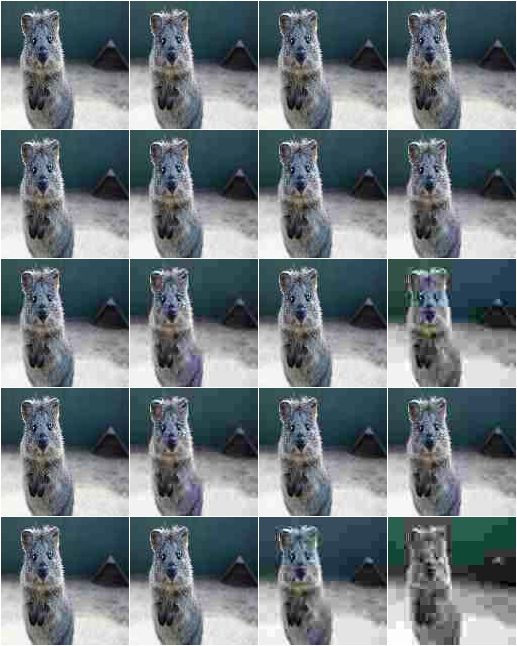augmenters.arithmetic¶
Add¶
Add a value to all pixels in an image.
API link: Add
Example. Add random values between -40 and 40 to images, with each value being sampled once per image and then being the same for all pixels:
import imgaug.augmenters as iaa
aug = iaa.Add((-40, 40))

Example. Add random values between -40 and 40 to images. In 50% of all images the values differ per channel (3 sampled value). In the other 50% of all images the value is the same for all channels:
aug = iaa.Add((-40, 40), per_channel=0.5)
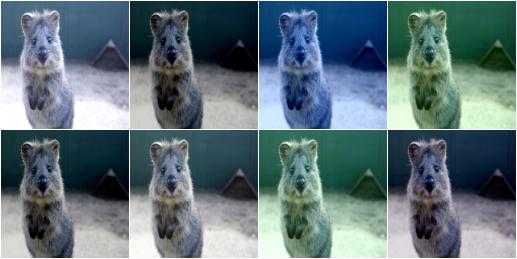
AddElementwise¶
Add values to the pixels of images with possibly different values for neighbouring pixels.
API link: AddElementwise
Example. Add random values between -40 and 40 to images, with each value being sampled per pixel:
import imgaug.augmenters as iaa
aug = iaa.AddElementwise((-40, 40))
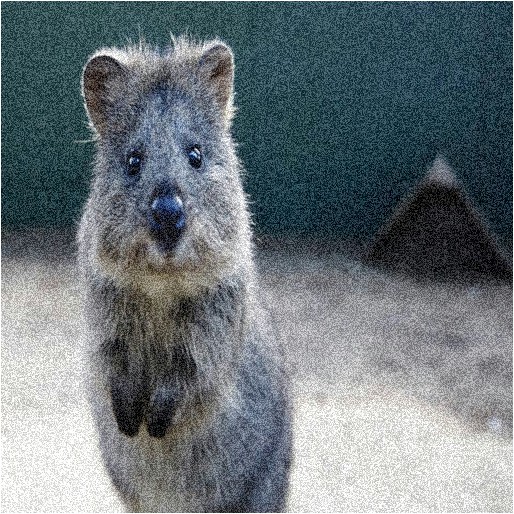
Example. Add random values between -40 and 40 to images. In 50% of all images the values differ per channel (3 sampled values per pixel). In the other 50% of all images the value is the same for all channels per pixel:
aug = iaa.AddElementwise((-40, 40), per_channel=0.5)
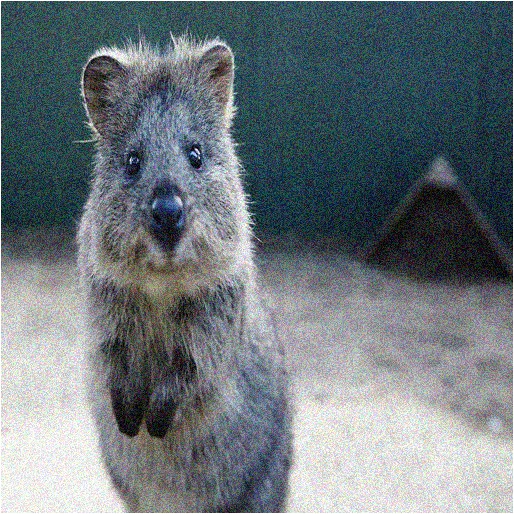
AdditiveGaussianNoise¶
Add noise sampled from gaussian distributions elementwise to images.
API link: AdditiveGaussianNoise()
Example.
Add gaussian noise to an image, sampled once per pixel from a normal
distribution N(0, s), where s is sampled per image and varies between
0 and 0.2*255:
import imgaug.augmenters as iaa
aug = iaa.AdditiveGaussianNoise(scale=(0, 0.2*255))
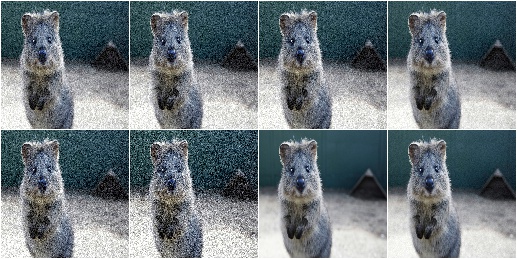
Example.
Add gaussian noise to an image, sampled once per pixel from a normal
distribution N(0, 0.05*255):
aug = iaa.AdditiveGaussianNoise(scale=0.2*255)
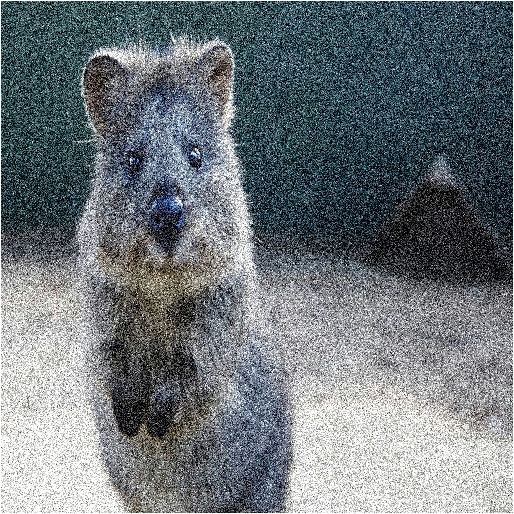
Example.
Add gaussian noise to an image, sampled channelwise from
N(0, 0.2*255) (i.e. three independent samples per pixel):
aug = iaa.AdditiveGaussianNoise(scale=0.2*255, per_channel=True)
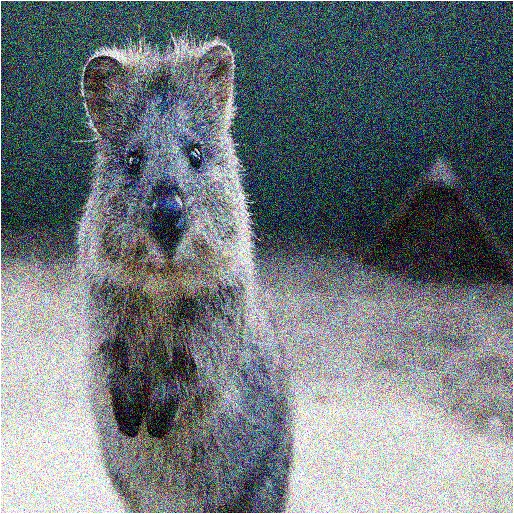
AdditiveLaplaceNoise¶
Add noise sampled from laplace distributions elementwise to images.
The laplace distribution is similar to the gaussian distribution, but puts more weight on the long tail. Hence, this noise will add more outliers (very high/low values). It is somewhere between gaussian noise and salt and pepper noise.
API link: AdditiveLaplaceNoise()
Example.
Add laplace noise to an image, sampled once per pixel from Laplace(0, s),
where s is sampled per image and varies between 0 and 0.2*255:
import imgaug.augmenters as iaa
aug = iaa.AdditiveLaplaceNoise(scale=(0, 0.2*255))
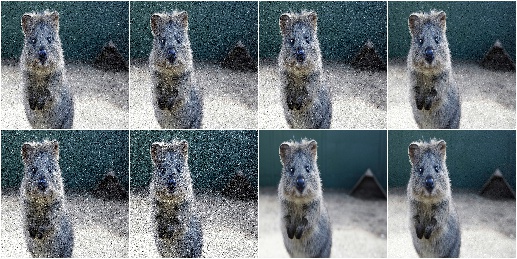
Example.
Add laplace noise to an image, sampled once per pixel from
Laplace(0, 0.2*255):
aug = iaa.AdditiveLaplaceNoise(scale=0.2*255)
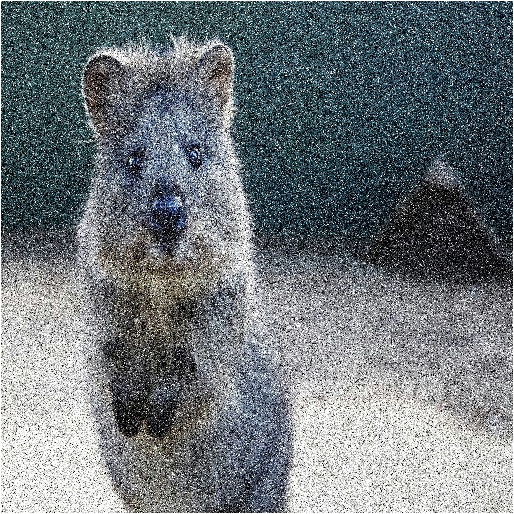
Example.
Add laplace noise to an image, sampled channelwise from
Laplace(0, 0.2*255) (i.e. three independent samples per pixel):
aug = iaa.AdditiveLaplaceNoise(scale=0.2*255, per_channel=True)

AdditivePoissonNoise¶
Add noise sampled from poisson distributions elementwise to images.
Poisson noise is comparable to gaussian noise, as e.g. generated via
AdditiveGaussianNoise. As poisson distributions produce only positive
numbers, the sign of the sampled values are here randomly flipped.
Values of around 20.0 for lam lead to visible noise (for uint8).
Values of around 40.0 for lam lead to very visible noise (for
uint8).
It is recommended to usually set per_channel to True.
API link: AdditivePoissonNoise()
Example.
Add poisson noise to an image, sampled once per pixel from Poisson(lam),
where lam is sampled per image and varies between 0 and 40:
import imgaug.augmenters as iaa
aug = iaa.AdditivePoissonNoise(scale=(0, 40))
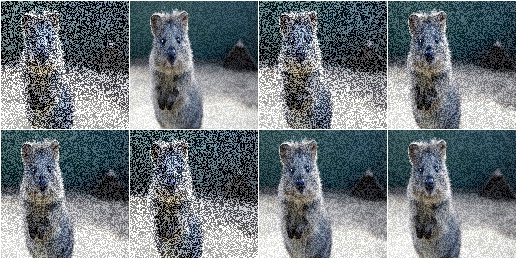
Example.
Add poisson noise to an image, sampled once per pixel from Poisson(40):
aug = iaa.AdditivePoissonNoise(40)
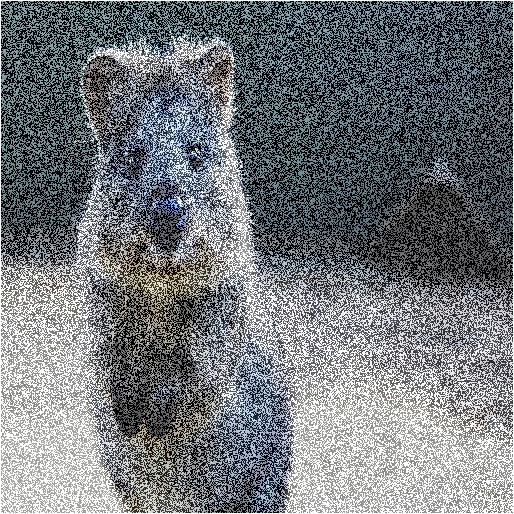
Example.
Add poisson noise to an image, sampled channelwise from
Poisson(40) (i.e. three independent samples per pixel):
aug = iaa.AdditivePoissonNoise(scale=40, per_channel=True)
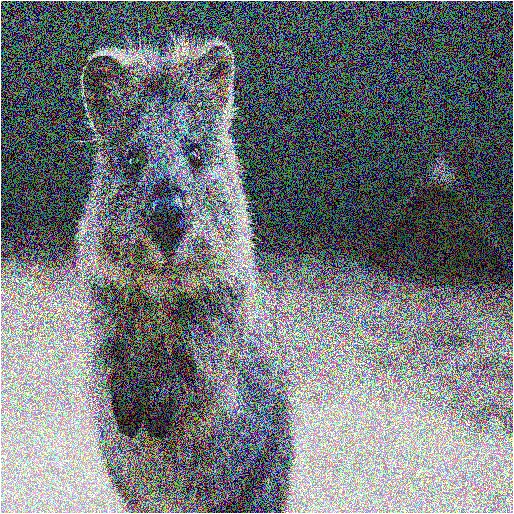
Multiply¶
Multiply all pixels in an image with a specific value, thereby making the image darker or brighter.
API link: Multiply
Example. Multiply each image with a random value between 0.5 and 1.5:
import imgaug.augmenters as iaa
aug = iaa.Multiply((0.5, 1.5))

Example. Multiply 50% of all images with a random value between 0.5 and 1.5 and multiply the remaining 50% channel-wise, i.e. sample one multiplier independently per channel:
aug = iaa.Multiply((0.5, 1.5), per_channel=0.5)

MultiplyElementwise¶
Multiply values of pixels with possibly different values for neighbouring pixels, making each pixel darker or brighter.
API link: MultiplyElementwise
Example. Multiply each pixel with a random value between 0.5 and 1.5:
import imgaug.augmenters as iaa
aug = iaa.MultiplyElementwise((0.5, 1.5))

Example. Multiply in 50% of all images each pixel with random values between 0.5 and 1.5 and multiply in the remaining 50% of all images the pixels channel-wise, i.e. sample one multiplier independently per channel and pixel:
aug = iaa.MultiplyElementwise((0.5, 1.5), per_channel=0.5)

Cutout¶
Fill one or more rectangular areas in an image using a fill mode.
See paper “Improved Regularization of Convolutional Neural Networks with Cutout” by DeVries and Taylor.
In contrast to the paper, this implementation also supports replacing image sub-areas with gaussian noise, random intensities or random RGB colors. It also supports non-squared areas. While the paper uses absolute pixel values for the size and position, this implementation uses relative values, which seems more appropriate for mixed-size datasets. The position parameter furthermore allows more flexibility, e.g. gaussian distributions around the center.
Note
This augmenter affects only image data. Other datatypes (e.g. segmentation map pixels or keypoints within the filled areas) are not affected.
Note
Gaussian fill mode will assume that float input images contain values
in the interval [0.0, 1.0] and hence sample values from a
gaussian within that interval, i.e. from N(0.5, std=0.5/3).
API link: MultiplyElementwise
Example. Fill per image two random areas, by default with grayish pixels:
import imgaug.augmenters as iaa
aug = iaa.Cutout(nb_iterations=2)
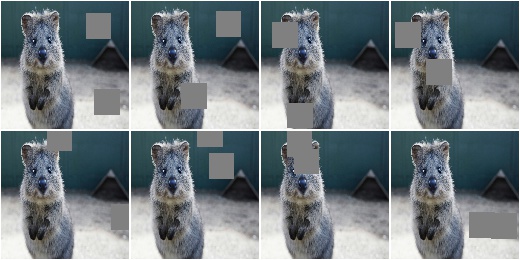
Example.
Fill per image between one and five areas, each having 20%
of the corresponding size of the height and width (for non-square
images this results in non-square areas to be filled).
aug = iaa.Cutout(nb_iterations=(1, 5), size=0.2, squared=False)
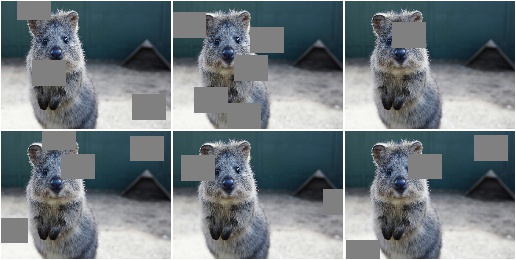
Example. Fill all areas with white pixels:
aug = iaa.Cutout(fill_mode="constant", cval=255)
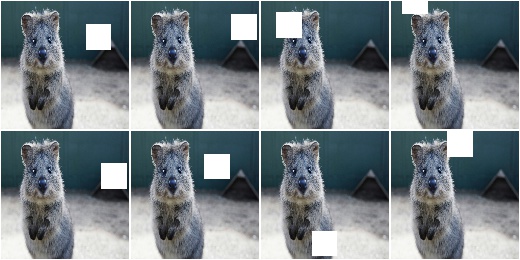
Example.
Fill 50% of all areas with a random intensity value between
0 and 256. Fill the other 50% of all areas with random colors.
aug = iaa.Cutout(fill_mode="constant", cval=(0, 255),
fill_per_channel=0.5)
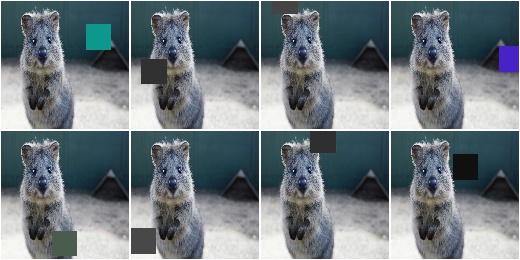
Example. Fill areas with gaussian channelwise noise (i.e. usually RGB).
aug = iaa.Cutout(fill_mode="gaussian", fill_per_channel=True)
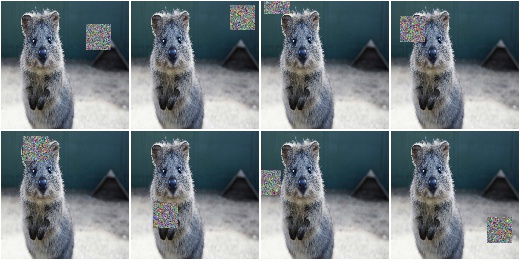
Dropout¶
Augmenter that sets a certain fraction of pixels in images to zero.
API link: Dropout()
Example.
Sample per image a value p from the range 0<=p<=0.2 and then drop
p percent of all pixels in the image (i.e. convert them to black pixels):
import imgaug.augmenters as iaa
aug = iaa.Dropout(p=(0, 0.2))
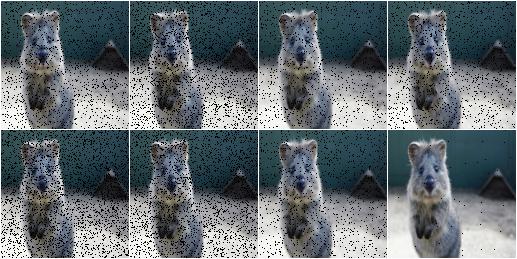
Example.
Sample per image a value p from the range 0<=p<=0.2 and then drop
p percent of all pixels in the image (i.e. convert them to black pixels),
but do this independently per channel in 50% of all images:
aug = iaa.Dropout(p=(0, 0.2), per_channel=0.5)
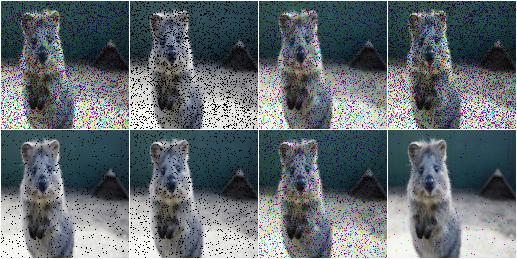
CoarseDropout¶
Augmenter that sets rectangular areas within images to zero.
API link: CoarseDropout()
Example. Drop 2% of all pixels by converting them to black pixels, but do that on a lower-resolution version of the image that has 50% of the original size, leading to 2x2 squares being dropped:
import imgaug.augmenters as iaa
aug = iaa.CoarseDropout(0.02, size_percent=0.5)

Example. Drop 0 to 5% of all pixels by converting them to black pixels, but do that on a lower-resolution version of the image that has 5% to 50% of the original size, leading to large rectangular areas being dropped:
import imgaug.augmenters as iaa
aug = iaa.CoarseDropout((0.0, 0.05), size_percent=(0.02, 0.25))
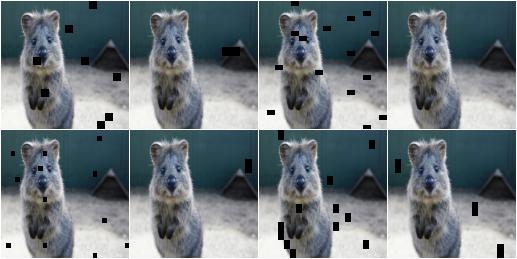
Example. Drop 2% of all pixels by converting them to black pixels, but do that on a lower-resolution version of the image that has 50% of the original size, leading to 2x2 squares being dropped. Also do this in 50% of all images channel-wise, so that only the information of some channels in set to 0 while others remain untouched:
aug = iaa.CoarseDropout(0.02, size_percent=0.15, per_channel=0.5)
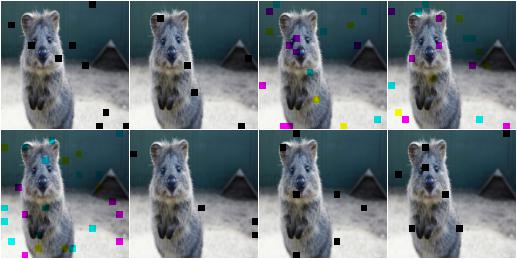
Dropout2D¶
Drop random channels from images.
For image data, dropped channels will be filled with zeros.
Note
This augmenter may also set the arrays of heatmaps and segmentation
maps to zero and remove all coordinate-based data (e.g. it removes
all bounding boxes on images that were filled with zeros).
It does so if and only if all channels of an image are dropped.
If nb_keep_channels >= 1 then that never happens.
API link: Dropout2d()
Example. Create a dropout augmenter that drops on average half of all image channels. Dropped channels will be filled with zeros. At least one channel is kept unaltered in each image (default setting).
import imgaug.augmenters as iaa
aug = iaa.Dropout2d(p=0.5)
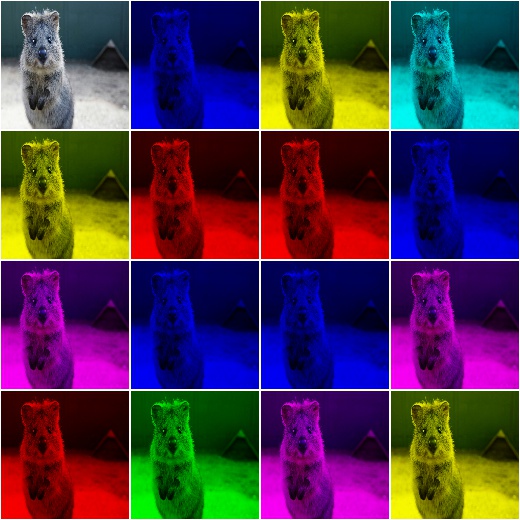
Example. Create a dropout augmenter that drops on average half of all image channels and may drop all channels in an image (i.e. images may contain nothing but zeros):
import imgaug.augmenters as iaa
aug = iaa.Dropout2d(p=0.5, nb_keep_channels=0)

TotalDropout¶
Drop all channels of a defined fraction of all images.
For image data, all components of dropped images will be filled with zeros.
Note
This augmenter also sets the arrays of heatmaps and segmentation maps to zero and removes all coordinate-based data (e.g. it removes all bounding boxes on images that were filled with zeros).
API link: TotalDropout()
Example. Create an augmenter that sets all components of all images to zero:
import imgaug.augmenters as iaa
aug = iaa.TotalDropout(1.0)
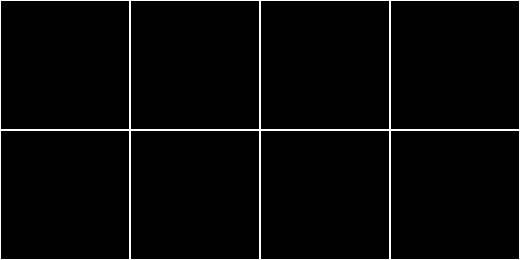
Example.
Create an augmenter that sets all components of 50% of all images to
zero:
aug = iaa.TotalDropout(0.5)

ReplaceElementwise¶
Replace pixels in an image with new values.
API link: ReplaceElementwise
Example.
Replace 10% of all pixels with either the value 0 or the value
255:
import imgaug.augmenters as iaa
aug = ReplaceElementwise(0.1, [0, 255])
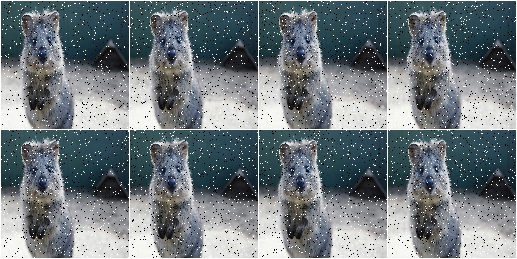
Example.
For 50% of all images, replace 10% of all pixels with either the value
0 or the value 255 (same as in the previous example). For the other
50% of all images, replace channelwise 10% of all pixels with either
the value 0 or the value 255. So, it will be very rare for each pixel
to have all channels replaced by 255 or 0.
aug = ReplaceElementwise(0.1, [0, 255], per_channel=0.5)
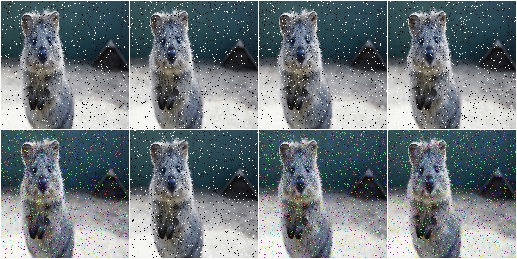
Example.
Replace 10% of all pixels by gaussian noise centered around 128. Both
the replacement mask and the gaussian noise are sampled for 50% of all
images.
import imgaug.parameters as iap
aug = ReplaceElementwise(0.1, iap.Normal(128, 0.4*128), per_channel=0.5)
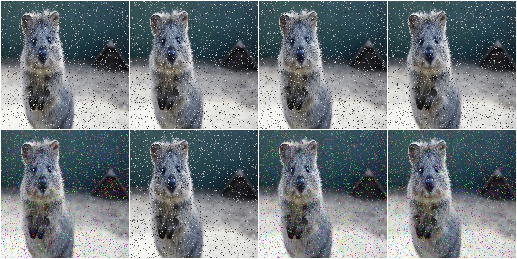
Example.
Replace 10% of all pixels by gaussian noise centered around 128. Sample
the replacement mask at a lower resolution (8x8 pixels) and upscale it to
the image size, resulting in coarse areas being replaced by gaussian noise.
aug = ReplaceElementwise(
iap.FromLowerResolution(iap.Binomial(0.1), size_px=8),
iap.Normal(128, 0.4*128),
per_channel=0.5)
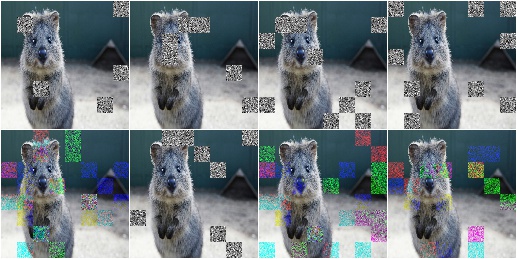
ImpulseNoise¶
Add impulse noise to images.
This is identical to SaltAndPepper, except that per_channel is
always set to True.
API link: ImpulseNoise()
Example.
Replace 10% of all pixels with impulse noise:
import imgaug.augmenters as iaa
aug = iaa.ImpulseNoise(0.1)
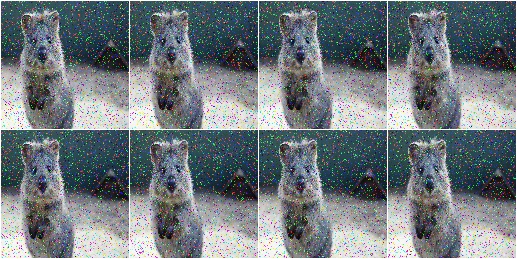
SaltAndPepper¶
Replace pixels in images with salt/pepper noise (white/black-ish colors).
API link: SaltAndPepper()
Example.
Replace 10% of all pixels with salt and pepper noise:
import imgaug.augmenters as iaa
aug = iaa.SaltAndPepper(0.1)
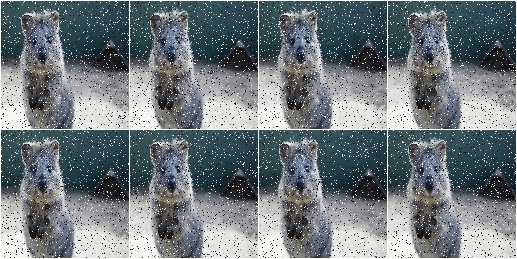
Example.
Replace channelwise 10% of all pixels with salt and pepper
noise:
aug = iaa.SaltAndPepper(0.1, per_channel=True)
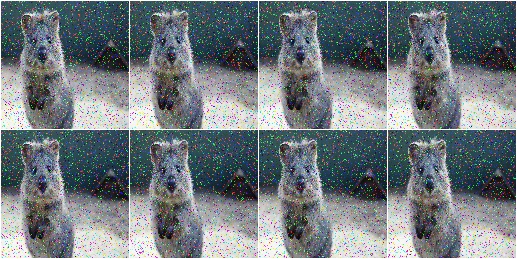
CoarseSaltAndPepper¶
Replace rectangular areas in images with white/black-ish pixel noise.
API link: CoarseSaltAndPepper()
Example.
Mark 5% of all pixels in a mask to be replaced by salt/pepper
noise. The mask has 1% to 10% the size of the input image.
The mask is then upscaled to the input image size, leading to large
rectangular areas being marked as to be replaced. These areas are then
replaced in the input image by salt/pepper noise.
import imgaug.augmenters as iaa
aug = iaa.CoarseSaltAndPepper(0.05, size_percent=(0.01, 0.1))
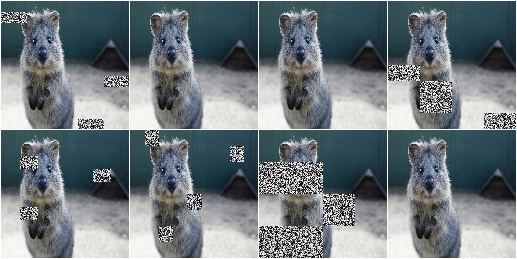
Example.
Same as in the previous example, but the replacement mask before upscaling
has a size between 4x4 and 16x16 pixels (the axis sizes are sampled
independently, i.e. the mask may be rectangular).
aug = iaa.CoarseSaltAndPepper(0.05, size_px=(4, 16))
Example. Same as in the first example, but mask and replacement are each sampled independently per image channel.
aug = iaa.CoarseSaltAndPepper(
0.05, size_percent=(0.01, 0.1), per_channel=True)
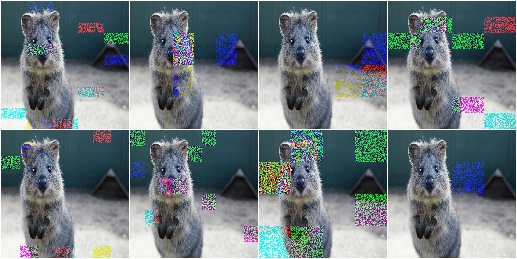
Salt¶
Replace pixels in images with salt noise, i.e. white-ish pixels.
This augmenter is similar to SaltAndPepper, but adds no pepper noise to
images.
API link: Salt()
Example.
Replace 10% of all pixels with salt noise (white-ish colors):
import imgaug.augmenters as iaa
aug = iaa.Salt(0.1)

Example.
Similar to SaltAndPepper, this augmenter also supports the per_channel
argument, which is skipped here for brevity.
CoarseSalt¶
Replace rectangular areas in images with white-ish pixel noise.
This augmenter is similar to CoarseSaltAndPepper, but adds no pepper noise
to images.
API link: CoarseSalt()
Example.
Mark 5% of all pixels in a mask to be replaced by salt
noise. The mask has 1% to 10% the size of the input image.
The mask is then upscaled to the input image size, leading to large
rectangular areas being marked as to be replaced. These areas are then
replaced in the input image by salt noise.
import imgaug.augmenters as iaa
aug = iaa.CoarseSalt(0.05, size_percent=(0.01, 0.1))

Similar to CoarseSaltAndPepper, this augmenter also supports the
per_channel argument, which is skipped here for brevity
Pepper¶
Replace pixels in images with pepper noise, i.e. black-ish pixels.
This augmenter is similar to SaltAndPepper, but adds no salt noise to
images.
This augmenter is similar to Dropout, but slower and the black pixels are
not uniformly black.
API link: Pepper()
Example.
Replace 10% of all pixels with pepper noise (black-ish colors):
import imgaug.augmenters as iaa
aug = iaa.Pepper(0.1)

Similar to SaltAndPepper, this augmenter also supports the per_channel
argument, which is skipped here for brevity.
CoarsePepper¶
Replace rectangular areas in images with black-ish pixel noise.
This augmenter is similar to CoarseSaltAndPepper, but adds no salt noise
to images.
API link: CoarsePepper()
Example.
Mark 5% of all pixels in a mask to be replaced by pepper
noise. The mask has 1% to 10% the size of the input image.
The mask is then upscaled to the input image size, leading to large
rectangular areas being marked as to be replaced. These areas are then
replaced in the input image by pepper noise.
import imgaug.augmenters as iaa
aug = iaa.CoarsePepper(0.05, size_percent=(0.01, 0.1))
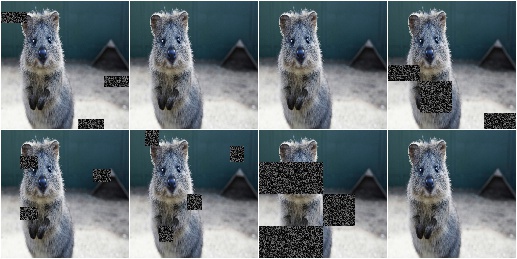
Similar to CoarseSaltAndPepper, this augmenter also supports the
per_channel argument, which is skipped here for brevity
Invert¶
Augmenter that inverts all values in images, i.e. sets a pixel from value
v to 255-v.
API link: Invert
Example. Invert in 50% of all images all pixels:
import imgaug.augmenters as iaa
aug = iaa.Invert(0.5)

Example. For 50% of all images, invert all pixels in these images with 25% probability (per image). In the remaining 50% of all images, invert 25% of all channels:
aug = iaa.Invert(0.25, per_channel=0.5)

Solarize¶
Invert all values above a threshold in images.
This is the same as Invert, but sets a default threshold around
128 (+/- 64, decided per image) and default invert_above_threshold
to True (i.e. only values above the threshold will be inverted).
API link: Solarize
Example.
Invert the colors in 50 percent of all images for pixels with a
value between 32 and 128 or more. The threshold is sampled once
per image. The thresholding operation happens per channel.
import imgaug.augmenters as iaa
aug = iaa.Solarize(0.5, threshold=(32, 128))

JpegCompression¶
Degrade the quality of images by JPEG-compressing them.
API link: JpegCompression
Example.
Remove high frequency components in images via JPEG compression with
a compression strength between 80 and 95 (randomly and
uniformly sampled per image). This corresponds to a (very low) quality
setting of 5 to 20.
import imgaug.augmenters as iaa
aug = iaa.JpegCompression(compression=(70, 99))
